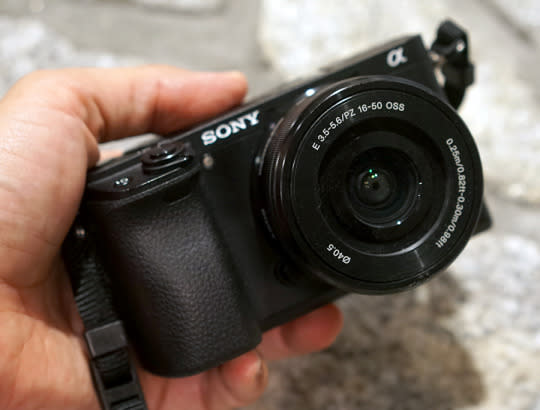The Sony a6300 camera: Stunning photos and videos in a tiny package
As you may have noticed, Apple has been plastering billboards and magazine pages with photos taken by iPhones.
What you may not have noticed is that they’re all basically snapshots. The subjects are either landscapes or people five feet away. There’s not much freezing of motion, not much low light. That is, you won’t see many photos like these on a “Taken by iPhone 6” billboard:
And no wonder: Phone cameras can’t zoom. They don’t have manual controls. They don’t take interchangeable lenses. Their sensors aren’t big enough to freeze motion in low light.
In the last few years, a company once left for dead in the camera marketplace has come screaming back, eating Nikon’s and Canon’s lunches in certain categories of camera: Sony. Its magic formula: Stuff great big sensors into tiny little cameras. (If you care, here’s why that radical idea is so effective.) The one I’ve been carrying around for a couple of months, the flagship of Sony’s mid-size line, is called the a6300.

Now, this camera costs $1,150 with a lens. I know, I know: For that money, shouldn’t you be getting a bigger professional camera?
But that’s the fallacy of camera-size thinking. To many people, a smaller camera is more valuable than a bigger one, as long as they’re equally good at photos and videos. Miniaturization ain’t free.
The a6300 contains an APS-C sensor, shown here second from left (these are accurate relative to each other, but not actual size):

Bigger sensors are better. They make better photos and videos possible (better clarity, color, blurry-background effects, and so on).
If you can handle the concept of a coat-pocketable SLR that costs over a grand, you have a lot to look forward to. Here are some of the highlights.
World’s fastest focusing
The a6300 is the successor to Sony’s a6000, which Sony says is the best-selling mirrorless camera in history. (A mirrorless camera is just like an SLR, but smaller, because it eliminates the whole mirror/prism apparatus. Here’s a primer.)
Although the two cameras look nearly identical, there’s a lot of improvement under the 6300’s hood. Among the upgrades: The body is a magnesium alloy instead of plastic, and it’s dust- and weather-resistant. (I can confirm: the camera got plenty rained on when I filmed my kids enjoying a local lightning storm last week, and it didn’t mind a bit.)

There’s also a microphone input now, which is incredibly useful if you’re serious about video. (There is not, alas, a headphone jack, although you can buy an external mike that includes a headphone jack.) The optical viewfinder is spectacularly fast and clear.
The camera can record 4K video now, and it can also shoot ¼-speed slow-motion (that is, 120 frames per second — very rare in this price class). Here’s what it looks like to drop a head of garlic into a glass of water — first in real time, then in slo-mo:
But the biggest headline is the a6300’s insanely fast, sure focusing system. Sony claims this is the fastest-focusing camera on earth, capable of attaining focus lock in 1/20th of a second.
On the camera’s new 24-megapixel sensor, furthermore, there are 425 focus points.
Here’s a teachable techie moment: A focus point is a pair of pixels, two among the 24 million on a camera’s sensor chip. With phase-detection autofocus (the good kind), the camera figures out how to attain sharp focus by comparing the light striking a given pair of these special pixels. The more focus points there are, the smarter the camera can be about keeping a subject sharp as it moves. Most cameras in this price range have, say, 120 focus points. The Sony’s much denser array make quick work of tracking shots like these racing piggies (notice how they’re always in focus, even as they move, even though the foreground and background are both nicely blurred):

The quick focusing, subject tracking, and 11-shots-a-second burst mode all make the a6300 a sensational choice for action shooting, like sports.
Ditto for the smart-tracking mode; you get “only” 8 frames a second in this mode, but the camera can keep tracking a moving subject even if something passes between you and it.
The a6300 also an incredible video shooter. No, not many people have 4K screens on which to play back 4K video—but if you use the a6300 to film in 4K and then convert it to regular 1080p high definition, you benefit from sharper, better-looking results than if you’d shot at 1080p in the first place. (In fact, this camera actually captures 6K—that is, six times as much picture data as high-defintion video—which it then scales down to 4K for even better color and clarity.)
A note about lenses
The a6300 can accommodate a huge range of lenses — not just fit them, but autofocus them in a fraction of a second, too. That includes 34 of Sony’s E-mount lenses and, with a lens adapter, 37 of Sony’s A-mount lenses. And that doesn’t even include the compatible lenses from companies like Sigma and Tamron.

I even got to try out the a6300 with some of Sony’s new, top-of-the-line, top-of-the-price G-series master lenses. Wow.
(Examples: a lens that zooms from 24 to 70mm, with a constant aperture of f/2.8, for $2,200. Glorious. Or an 85mm non-zooming f/1.4 lens for astonishing portraits and luscious blurry backgrounds for $1,800. Yeah, gulp — but like I said: wow.)
Nits in the ointment
You’d be hard-pressed to find anyone who will declare that any rival camera on earth produces better images and videos. The Sony a6300, for its size and price, rips apart anything else on the market.
So: Image quality, video quality, size, and price: A+. (I’ve posted the full-resolution originals of all photos in this review, plus a few more, right here, for your pixel-peeping pleasure.)
There is, alas, more to a camera than that, and people who’ve lived with the a6300 for a while have lists of legitimate complaints.
The battery. This is not Sony’s finest moment. You get 350 shots per charge. That’s better than the older a6000, but nothing like the 1,100 shots of the rival Nikon D7200, or 960 shots on the Canon 80D. (You can operate the Sony while it’s plugged into power, but that’s only a partial solution.)
The tilt screen. It looks great. But it’s not a touchscreen like the one on the Canon 80D, it doesn’t tilt down much, and it definitely doesn’t tilt and swivel to face completely forward.
Overheating during video. When shooting 4K video, some a6300 owners say the recording shuts off after about 20 minutes of continuous shooting. (It’s not a problem when you’re shooting regular HD footage.) I never encountered that problem, which seems to arise more often if you’re shooting in direct sunlight on a hot day. But Google it for other people’s accounts, and some workarounds.
“Jelly” rolling shutter effect. In the 4K modes, if you pan the camera sideways fast, your image can distort, wiggling as though it’s on Jell-O. This video shows the effect well. (Start at about 1:30 into the video.)
Ergonomics. Frequent photographers complain a lot about the a6300’s control layout. On a “real” SLR, your right index finger rests on a front dial for quick aperture changes (forexample)—but on the a6300, that dial is on the back, so you have to shift your grip to turn it.
Movie button. Then there’s the much-maligned Record Movie button, a tiny, lonely, indented button on the back-right corner of the camera. It’s nice to have a dedicated button like this, so that you can start filming no matter what mode you’re in—but when you’ve set the top mode dial to Movie mode, why can’t you use the shutter button to start and stop video, as you’d expect?
What really matters?
There’s no such thing as a perfect camera. You want better battery life and a better button layout? Then you’ll have to get a bigger, heavier camera. You want lower price? Then you’ll have to settle for a smaller sensor, and your photos won’t be as good.
For the advanced amateur, or for, say, the parent who wants to do the best job possible in capturing the kids’ golden first years, I’d think that stunning photo and video quality, compact size, astounding low-light capability, and insta-focusing on action would be some of the most important qualifications in a camera.
Obviously, the designers of the Sony a6300 thought so, too.
David Pogue is the founder of Yahoo Tech; here’s how to get his columns by email. On the Web, he’s davidpogue.com. On Twitter, he’s @pogue. On email, he’s poguester@yahoo.com. He welcomes non-toxic comments in the Comments below.

 Yahoo Finance
Yahoo Finance 







